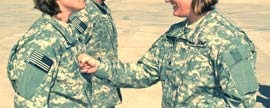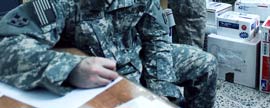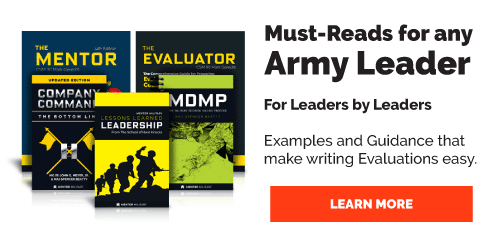AR 600-20 Army Command Policy
4–6. Exercising military authority
a. Military authority is exercised promptly, firmly, courteously and fairly. Commanders should consider administrative corrective measures before deciding to impose non-judicial punishment. Trial by court-martial is ordinarily inappropriate for minor offenses unless lesser forms of administering discipline would be ineffective (see MCM, Part V, and chap 3, AR 27–10).
b. One of the most effective administrative corrective measures is extra training or instruction (including on-the-spot correction). For example, if Soldiers appear in an improper uniform, they are required to correct it immediately; if they do not maintain their housing area properly, they must correct the deficiency in a timely manner. If Soldiers have training deficiencies, they will be required to take extra training or instruction in subjects directly related to the shortcoming.
(1) The training, instruction, or correction given to a Soldier to correct deficiencies must be directly related to the deficiency. It must be oriented to improving the Soldier’s performance in his or her problem area. Corrective measures may be taken after normal duty hours. Such measures assume the nature of training or instruction, not punishment. Corrective training should continue only until the training deficiency is overcome. Authority to use it is part of the inherent powers of command.
(2) Care should be taken at all levels of command to ensure that training and instruction are not used in an oppressive manner to evade the procedural safeguards applying to imposing non-judicial punishment. Deficiencies satisfactorily corrected by means of training and instruction will not be noted in the official records of the Soldiers concerned.
4–19. Treatment of persons
The Army is a values-based organization where everyone is expected to do what is right by treating all persons as they should be treated – with dignity and respect. Hazing, bullying, and other behaviors that undermine dignity and respect are fundamentally in opposition to our values and are prohibited. This paragraph is punitive. Soldiers who violate this policy may be subject to punishment under the UCMJ. Whether or not certain acts specifically violate the provisions of this paragraph, they may be inappropriate or violate relevant civilian personnel guidance. Commanders must seek the advice and counsel of their legal advisor when taking actions pursuant to this paragraph.
a. Definition.
(1) Hazing. Any conduct whereby a Servicemember or members regardless of service, rank, or position, and without proper authority, recklessly or intentionally causes a Servicemember to suffer or be exposed to any activity that is cruel, abusive, humiliating, oppressive, demeaning, or harmful. Soliciting or coercing another to participate in any such activity is also considered hazing. Hazing need not involve physical contact among or between military members or employees; it can be verbal or psychological in nature. Likewise, it need not be committed in the physical presence of
the victim; it may be accomplished through written or phone messages, text messages, email, social media, or any other virtual or electronic medium. Actual or implied consent to acts of hazing does not eliminate the culpability of the perpetrator. Without outside intervention, hazing conduct typically stops at an identified end-point.
(2) Bullying. Bullying is any conduct whereby a Servicemember or members, regardless of service, rank, or position, intends to exclude or reject another Servicemember through cruel, abusive, humiliating, oppressive, demeaning, or harmful behavior, which results in diminishing the other Servicemember’s dignity, position, or status. Absent outside intervention, bullying will typically continue without any identifiable end-point. Bullying may include an abuse of authority. Bullying tactics include, but are not limited to, making threats, spreading rumors, social isolation, and
attacking someone physically, verbally, or through the use of electronic media.
b. Scope.
(1) What constitutes hazing and bullying? Hazing and bullying can include both physical and nonphysical interactions. Hazing typically involves conduct directed at new members of an organization or individuals who have recently achieved a career milestone. It may result from any form of initiation, “rite of passage,” or congratulatory act that includes unauthorized conduct such as: physically striking another while intending to cause, or causing, the infliction of pain or other physical marks such as bruises, swelling, broken bones, internal injuries; piercing another’s skin in any
manner; forcing or requiring the consumption of excessive amounts of food, alcohol, drugs, or other substances; or encouraging another to engage in illegal, harmful, demeaning, or unauthorized dangerous acts. Unlike hazing, bullying often, but not always, takes the form of excessive corrective measures that, like hazing, involve the infliction of physical or psychological pain and go beyond what is required for authorized corrective training.
(2) Hazing and bullying are not limited to superior-subordinate relationships. They may occur between peers or, under certain circumstances, may involve actions directed towards senior personnel by those junior in rank, grade, or position to them. Hazing may occur during graduation or promotion ceremonies or similar military “rites of passage.” However, it may also happen in military settings, such as in small units, to initiate or “welcome” a new member to the unit. Bullying may also occur in all settings but it most often appears as excessive correction of, or punishment for, perceived performance deficiencies. Hazing and bullying are prohibited in all cases, to include off-duty or “unofficial” celebrations or unit functions, on or off post.
AR 27-10 Military Justice
3–2. Use of non-judicial punishment
A Commander should use non-punitive measures to the fullest extent to further the efficiency of the command before resorting to non-judicial punishment (see para 1d(1), part V, MCM). Use of non-judicial punishment is proper in all cases involving minor offenses in which non-punitive measures are considered inadequate or inappropriate. If it is clear that non-judicial punishment will not be sufficient to meet the ends of justice, more stringent measures must be taken. Prompt action is essential for non-judicial punishment to have the proper corrective effect. Non-judicial punishment may be imposed to—
- Correct, educate, and reform offenders who the imposing Commander determines cannot benefit from less stringent measures.
- Preserve a Soldier’s record of service from unnecessary stigma by record of court-martial conviction.
- Further military efficiency by disposing of minor offenses in a manner requiring less time and personnel than trial by court-martial.
3–3. Relationship of non-judicial punishment to non-punitive measures (para 1g, part V, MCM)
General. Non-judicial punishment is imposed to correct misconduct in violation of the UCMJ. Such conduct may result from intentional disregard of or failure to comply with prescribed standards of military conduct. Non-punitive measures usually deal with misconduct resulting from simple neglect, forgetfulness, laziness, inattention to instructions, sloppy habits, immaturity, difficulty in adjusting to disciplined military life, and similar deficiencies. These measures are primarily tools for teaching proper standards of conduct and performance and do not constitute punishment. Included among non-punitive measures are denial of pass or other privileges, counseling, administrative reduction in grade, administrative reprimands and admonitions, extra training (see Army Regulation (AR) 600–20), bar to reenlistment, and military occupational specialty (MOS) reclassification. Certain Commanders may administratively reduce enlisted personnel for inefficiency and other reasons. This authority exists apart from any authority to punish misconduct under Article 15. These two separate and distinct kinds of authority should not be confused.
FM 7-22 Physical Readiness Training
5-15. Corrective Training
When exercise is used for corrective action, it is often performed incorrectly, promoting overtraining syndrome, and overuse injuries. Often corrective action mimics “smoke sessions,” punishing Soldiers with little or no corrective value. Consideration must be given to the number of times per day exercises are used for corrective action for individual Soldiers and groups of Soldiers to avoid the cumulative effect and limit the potential for overtraining syndrome. The following guidelines should be followed when employing exercise as corrective action. Only the following exercises should be selected for performance of corrective action.
- Rower
- Squat bender
- Windmill
- Prone row
- Push-up
- V-up
- Leg tuck and twist
- Supine bicycle
- Swimmer
- 8-count push-up
Only one of the above exercises may be selected for each corrective action. The number of repetitions should not exceed FIVE for any one of the exercises listed above.
JAG Information Paper
Corrective Training:
a. Corrective training or instruction may be used when a Soldier’s duty performance has been substandard or deficient and the Soldier would benefit from extra training. The training may be outside of normal duty hours. Corrective training may be authorized or directed by the Soldier’s Commander or by the noncommissioned officers in the Soldier’s chain of command.
b. Corrective training must be DIRECTLY RELATED to an observed deficiency and must be oriented toward improving the Soldier’s performance in the problem area. For example, an order to dig and fill holes is improper to correct a Soldier who continues to have a sloppy uniform. Training may not be used in an oppressive manner or to evade the procedural safeguards applicable to non-judicial punishment under Article 15, UCMJ. AR 27-10, para 3-3c.
AR 350-1 Army Training and Leader Development
Note: While AR 350-1 does not specifically address corrective training it cautions leaders to not to use physical fitness as a disciplinary measure.
4–13a. Army physical fitness training in units
(4) Special conditioning programs are appropriate for Soldiers who have difficulty meeting unit goals or Army standards. Such programs will not be punitive; they must be designed to improve the fitness level of Soldiers. Additional training sessions are not always a substitute for smart, tailored conditioning sessions and can lead to over training. Special conditioning programs will be designed to meet individual needs to overcome identified weaknesses (for example, aerobic or strength deficiency). In addition, they should encourage a healthy lifestyle.
(5) Special physical fitness programs will be tailored according to FM 7-22 and kept separate and distinct from the Army Body Composition Program, except for the exercise programs prescribed to assist Soldiers with weight control problems. Commanders should avoid placing all Soldiers that exceed body composition standards or have fitness problems in the same category with the expectation that more exercise will automatically result in decreased body composition and weight. Special programs will be employed for Soldiers with physical fitness problems. Separate special programs or additional PT is not always a solution to overcome identified weaknesses. Commanders are encouraged to place Soldiers with special fitness needs into the regular unit fitness program whenever possible. These programs will not be used to discipline Soldiers who may have attitude problems toward physical exercise.
For More Information on corrective training read the Mentor
, follow us, and sign up for our newsletter
Facebook: https://www.facebook.com/MentorMilitary/
Twitter: https://twitter.com/AskTOP
Newsletter: http://eepurl.com/bjcYH
I trust you found this information useful
TOP














